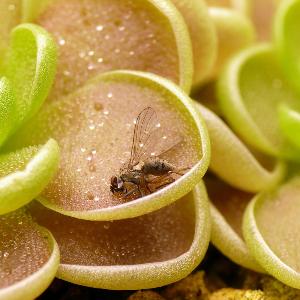As in cacti: CAM photosynthesis discovered in carnivorous plants
11 Nov 2025
Carnivorous plants of the genus Pinguicula (butterworts) apparently use the same water-saving photosynthesis type as many succulent plants.
11 Nov 2025
Carnivorous plants of the genus Pinguicula (butterworts) apparently use the same water-saving photosynthesis type as many succulent plants.

© Andreas Fleischmann
Botanists from LMU and the Bavarian State Collections of Natural History (SNSB) have now demonstrated CAM photosynthesis in carnivorous plants for the first time. The research team has published its findings in the journal Plant Biology.
Most carnivorous plants colonize wet, nutrient-poor habitats such as bogs or swamps. One of the few exceptions is the genus Pinguicula, known as butterworts: more than half of the approximately 110 species of butterwort known worldwide originate from the mountainous regions of subtropical Mexico. There, these small carnivorous plants thrive on rocky soils that are very dry for at least half of the year. Some of these species share their habitats with other typical “desert plants” such as cacti, agaves, and hechtias. Butterworts have so-called sticky traps, i.e., their leaves are covered with small glandular hairs that secrete sticky, glistening drops of a water-based trapping mucus.
Until now, it was unknown how the plants compensate for the lack of water in their dry habitats and still have enough water left to produce the sticky mucilage. A team of researchers from LMU and the Botanische Staatssammlung München (Bavarian State Collection for Botany) and the Botanical Garden Munich-Nymphenburg, which are part of the Bavarian State Collections of Natural History (SNSB) has now investigated this in several Mexican succulent species cultivated in the greenhouses of the Botanical Garden.
The experiments were conducted by Joris Fleck as part of his master's degree at LMU. He transferred the plants from their “comfort zone” in the greenhouse to climate chambers in which the growing conditions of Mexico's dry season were simulated. The photosynthesis of the plants under heat and drought stress was examined. The result was surprising: Butterworts apparently adapt their metabolism to drought.
They switch to what is known as CAM photosynthesis (CAM = Crassulacean Acid Metabolism), which is familiar from many drought-tolerant, succulent plants. In these plants, the stomata of the leaves remain closed during the day, so that CO2 cannot be absorbed for photosynthesis, but the plants also do not lose water through evaporation during the hot, dry daytime. The stomata open only at night and the plant “breathes” in CO2, which is stored. During the day, the plant draws on this carbon reserve from the night.
“We did not expect these results. We were not previously aware of the CAM photosynthesis pathway in carnivorous plants, not even among any close allies of the family Lentibulariaceae, to which butterworts belong,” says study leader Professor Gudrun Kadereit, director of the Bavarian State Collection for Botany, the Botanical Garden Munich and chair of systematic botany at LMU. “This brings the number of plant families in which CAM photosynthesis has evolved independently to 39.”
In view of climate change, the genus Pinguicula could be an interesting study group for further research. These carnivorous plants have evolved from moisture-loving marsh plants to drought-tolerant species. “So far, we have only been able to detect CAM photosynthesis in butterwort species from the evolutionarily young Mexican lineages of Pinguicula sections Agnata and Orcheosanthus, but not in any other species within the genus,” reports carnivorous plant expert Dr. Andreas Fleischmann from the Bavarian State Collection for Botany in Munich. “The butterwort species found in European Alps on moist soils and in calcareous fens show no signs of this specialized photosynthesis pathway in our studies.”
The current research results demonstrate the scientific importance of living collections in botanical gardens, as this study would not have been possible without the rich collection of cultivated carnivorous plants in the Munich-Nymphenburg Botanical Garden.
Joris Fleck et al.: Yes, we CAM! First evidence of CAM photosynthesis in a carnivorous plant. Plant Biology 2025